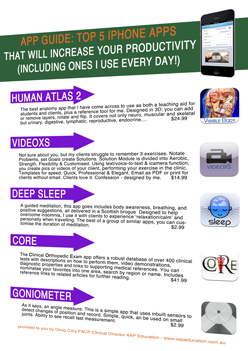|
If you live in rural Australia and practice acupuncture or dry needling it won’t be long before you have someone present with ‘unusual’ symptoms asking for a magical cure. It probably happens in metropolitan environs also, but talking with colleagues it seems more common in a rural situation.
Presentation
In this situation it was a lady in her mid 50s and her left eye was completely closed. She proceeded to explain that in addition to her eye closing, she had developed increasing frequency and severity of headaches on the L side - frontal and temporal. This had occurred over a period of a couple of months. It culminated in a GP visit while traveling in N.S.W. and was admitted to hospital. Following investigation, an unruptured aneurysm was detected ‘in her brain’, artery name unknown. She underwent endovascular coiling to seal and stabilize the aneurysm and spent a couple of days in recovery. While on the ward she met another lady, who said she had had exactly the same problem, and following 3 sessions of acupuncture, her eye had reopened. Hence on return to Esperance .......
On examination she presented as a frustrated person that was in otherwise good health and wanting to go back to work. In addition to her left eye being completely closed, her eyeball was situated in a lateral position. She had no voluntary eye control up, down or medially, but could move it far laterally. Her left pupil was also dilated.

At this point, I was pretty happy I had previously reviewed cranial nerve function and testing and reached for my printout. You can review a previous blog about quick clinical tests for cranial nerve function here and print out your copy!. She denied any alteration in skin temperature or moisture over her cheek or forehead.
What’s happening? - CN3
Eyelid & Pupil
The oculomotor nerve (CN3) supplies the upper eyelid muscle (levator palpebrae superioris) and the muscle responsible for pupil constriction (sphincter pupillae). Non functioning of the levator palpebrae superioris resulted in a closed eye (ptosis) and non functioning of the sphincter pupillae a dilated pupil (miosis). This presentation can also occur when the SNS function to the eye is interupted.
Eye Position
The oculomotor nerve supplies most of the eye movement muscles. Remembering eye muscle function (and associated CN innervation) maybe assisted with the chemical formulae - LR6SO4AO3: Lateral Rectus CN6, Superior Oblique CN4, All Others CN3) Without CN3 motor function, an unopposed LR pulls the eyeball laterally and an unopposed SO pulls the eyeball downward. The result is a ‘down and out’ eyeball. This would not occur with a SNS impairment.
Comments
On further reading, the artery involved was probably the posterior communicating. In addition, this was a ‘simple’ presentation as it involved all associated structures. Because of the branched nature of the nerve, ‘complex,’ partial variations of CN3 eye muscle involvement are common. Also with a compression lesions like this, the involvement of the PNS usually precedes motor involvement (hence the association with a Horner’s Syndrome).
Following discussion with a colleague more experienced in this area, I explained that compressive nerve lesions can improve over 6-12 months, following aneurysm stabilisation but outcomes are variable (resolving neuropraxia).
From the 2 following references comparisons of CN3 palsy recovery following surgical intervention like this shows that aneurysm clipping is more likely to result in resolution than coiling, since the latter does not reliably remove the mass effect of the aneurysm on the nerve. Furthermore, a total CN3 palsy has less recovery potential than partial palsy.
References
Chen PR et al. Outcome of oculomotor nerve palsy from posterior communicating artery aneurysms: comparison of clipping and coiling. Neurosurgery. Jun 2006;58(6):1040-6; discussion 1040-6. [Medline].
Leivo S et al. Early surgery improves the cure of aneurysm-induced oculomotor palsy. Surg Neurol. May 1996;45(5):430-4. [Medline].
All the best,
Doug Cary FACP
Specialist Musculoskeletal Physiotherapist (awarded by Australian College of Physiotherapy, 2009)
PhD Candidate Curtin University
Clinical Director AAP Education
email: doug@aapeducation.com.au
ph/fx: 08 90715055
Receive a FREE Information Report

Choose The Top 5 Manual Therapy Apps or Infection Control & Needling (V2)
Along with the report you'll also get a complimentary subscription to "Clinical Kit" our regular eZine (email newsletter) and Free Bronze Membership. You'll get ideas, information, insight and inspiration on a regular basis, plus access to our Resource Library, helping you unravel those clinical conundrums appearing every day.
You are free to use material from the Blog in whole or in part, as long as you include complete attribution, including live website link. Please also notify me where the material will appear. The attribution should read: "By Doug Cary FACP of AAP Education. Please visit our website at www.aapeducation.com.au for additional clinical articles and resources on post graduate education for health professionals" (Please make sure the link is live if placed in an eZine or in a web site.)
HOME | DRY NEEDLING PROGRAM | CERVICAL SPINE | FASCIAL MANIPULATION | MULLIGANS | MSK & RT ULTRASOUND | NEURODYNAMIC SOLUTIONS | THE SHOULDER | VESTIBULAR PROGRAM | LIVING ANATOMY WET LABS | BLOG
   
|

